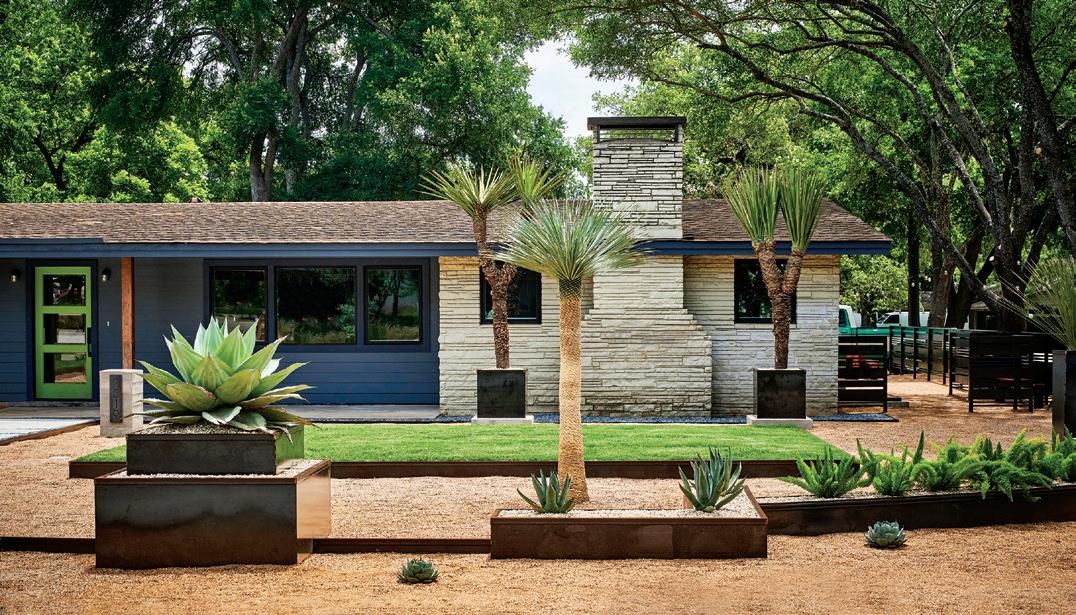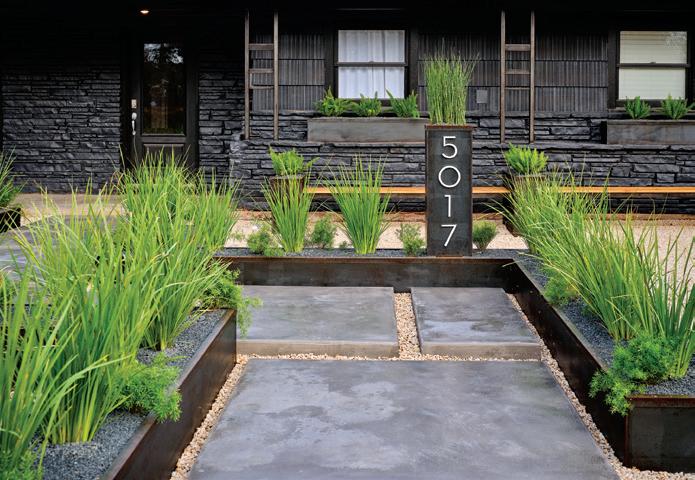
5 minute read
The Landscape Artist
L THE ANDSCAPE ARTIST
While the advantages of xeriscaping are many —
Advertisement
water conservation and low maintenance, for instance —
some homeowners still prefer the look of a traditional lawn.
Many people think of xeriscaping as a few wispy desert
plants in a field of rocks. But just one look at the work of
LUSH GreenScape Design, and they may change their mind.
By Claudia Alarcón Photography by Matthew Niemann
“I would argue that the exact opposite is true: a lawn is nice, but our landscapes are engaging on a deeper level; they really draw you in,” says Ryan S. McWhirter, owner of the company that specializes in landscaping with cacti and succulents. “We play with color and texture in a way that cannot be done with grass without sacrificing warmth and beauty.”
Although LUSH has nothing against grass, they just prefer to use it strategically as an accent, rather than as the feature. There are many ornamental grasses that are not typically used in lawns which they use to complement more architectural plants, adding a softness to the overall look and feel of their installations.
McWhirter likes to discuss their emphasis on function, even before form, with potential clients. “Our designs are nice to look at from the street, but they are primarily functional, outdoor living spaces,” he says. “They’re an extension of the home, and when you look at it that way, our work is an incredible value.” Once he gets these important

points across, the water conservation and low maintenance aspects are a given.
“People think of conservation on a personal scale, but billions — with a ‘b’ — of gallons of water are used on America’s lawns every day. That’s enormous,” says McWhirter. “Gas powered lawn mowers contribute significantly to air pollution, not to mention the millions of gallons of gasoline we spill annually that makes it into our waterways. Once you see conservation on a national scale, you have to question these conventional lawns and landscapes and take a more sustainable approach.”
Transforming a conventional lawn into a landscape that showcases succulents and cacti takes time and planning. The first part of the process is the design development phase, and the more elements taken into consideration, the more successful the installation. Topography, the structures within the landscape, existing plants — all this figures into the design. McWhirter also considers immediate neighbors and even the trend of the neighborhood. “Our work is modern, contemporary and it stands out, but it must fit in, too, for it to work,” he says. “So, we look at what’s going on as far as the properties around our projects. I think our designs are timeless, but we think about how they will fit with the general aesthetic for the foreseeable future. We approach it as holistically as possible.”
Planters and beds and architectural elements are obviously important, but plants must also be considered as they grow over time. “A five-gallon agave might be a thirty-gallon agave in a few years, and the space must be right visually when we finish and when we look at it again in a decade,” says McWhirter.
LUSH has put together a solid team of artisans in steel, stone and concrete, with a full understanding of the company’s quality standards and a grasp of the overall goals for each project. “Our team brings years of knowledge — it’s a collaborative effort that goes into the foundations of every installation,” says McWhirter. When ready to proceed with the transformation, they create a layout for all the concrete that will be poured in place — foundations for retainer walls, curbs and planters, as well as the formed steel.
First, the old lawn must be removed to make way for tons of heavy materials such as soil, stone, rock and steel — even the plants can be heavy. New beds settle over time, so it’s important that as they do, everything stays in place. “Poured concrete sounds so stark, but it’s a fantastic design element,” says McWhirter. Some grass is tenacious, and it will return given the opportunity, so they suppress it mechanically and apply a weed barrier. “Some weeding is inevitable, but even that is really minimized.”
With few exceptions, plants do not require irrigation, but water — everything from overland movement during flooding, to drainage, to water retention during drought, must be considered from the initial design consultation. McWhirter points out that while some watering is initially required to get the plants established and acclimated, it becomes sporadic since they are selected for their cold-hardiness and resistance to drought.


Cacti and succulents offer unique visual interest, with their naturally artistic and sculptural shapes. When selecting, McWhirter considers expected height of the mature plants, leaf and bloom colors, seasonal attributes and duration. “Our landscapes look great year-round,” he says. “Most of our plants are evergreen, and we try to stagger the blooming seasons so that there is usually something in flower.”
Specimen architectural plants create balance and serve as anchors and focal points. Some of McWhirter’s personal favorites include Argentine Saguaro, Queen Victoria Agave, Yucca decipiens, Golden Barrel Cactus and Agave neomexicana. “We look at the shape and texture of the mature plants and consider that against both the preexisting spaces and the ones we create,” he adds. “What we plant and where is critical to the composition of the landscape from an artistic or aesthetic perspective.”
Another advantage of these low maintenance landscapes is their staying power. “We take considerable pains to ensure the longevity of our work,” says McWhirter. “It looks great when we finish the project, and we expect it to look even better as it matures. Stone, concrete and steel weather beautifully, and over time it all seems to naturalize, to cohere into a kind of visual unity.”
While McWhirter thinks that LUSH has a signature look, they are conscious to avoid duplication as every design-build is tailored to the specific space. “It’s accurate to say that our approach is like that of a painter or a sculptor,” he says. “We use colors and textures and shapes as well as composition, and negative space plays an important role in our work, just as it does in other art forms.”
Xeriscaping offers a much broader palette for artistic expression. Compare that to swaths of brown, dormant grass, troublesome bare patches and all the attention that a nice lawn requires, and you’ll see it’s like night and day. u
LUSH GREENSCAPE DESIGN
210-823-7365 | www.lushgreenscape.com













